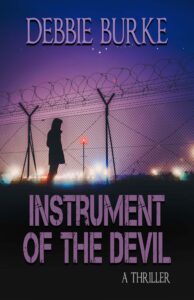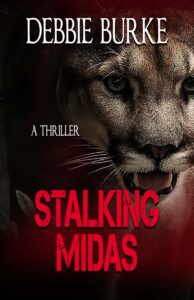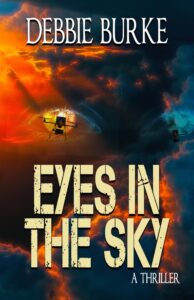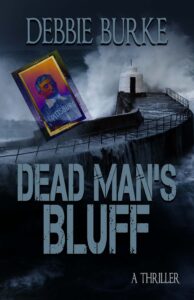By Debbie Burke
Recently I read an excellent post about flash fiction written by Nancy Stohlman on Jane Friedman’s blog.
One line leaped off the screen:
“Flash fiction has an almost desperate need to tell a story before it’s too late.”
Before it’s too late? What does that mean? Too late for what?
See what Nancy just did?
Something terrible could occur and you better keep reading to find out what it is.
Although Nancy was talking about flash fiction, the same principles apply to longer works.
Thrillers particularly are known for the breakneck pace that grabs readers by the throat and drags them along as the story unfolds.
But other genres can also achieve that compelling, can’t-put-it-down quality.
How does an author capture that sense of urgency?
Try these six tools:
1. Threats
In The Canterbury Tales, Chaucer wrote about the Sword of Damocles:
There was a sharpened sword above his head
That hung there by the thinnest simple thread.
Notice how just reading those lines makes you uneasy. That is the quality you want to provide for your readers.
Threats can start out minor but build to major.
Minor: being late to work.
Major: being late to work after the boss swore to fire you if you’re ever late again.
Minor: getting pulled over by a cop
Major: getting pulled over by a cop with a body in your trunk.
Threat level should increase as the story progresses. You might start with a petty annoyance. By the middle of the story, that annoyance has snowballed into a serious problem. At the climax, that problem has led to utter catastrophe for the character.
Threats need to maintain a consistent undertone of worry throughout the story. They may not always be front and center in the action but they should remain in the back of the reader’s mind, nagging and chafing like a popcorn kernel stuck between teeth.
Readers need to feel the thread is fraying and getting thinner with each chapter.
Is your pacing off or irregular? If so, the cause could be that a small threat occurs after a larger one. That causes a dip in the danger, a lessening of tension. Consider rewriting so each threat is progressively worse than the one before.
Exercise: Make a list of threats in your WIP. What is the overarching threat? What are the lesser threats? Do they build one on top of another, escalating the danger?
2. What else can go wrong?
Each scene needs a purpose or goal for the character to work toward.
By the end of the scene, the character has either achieved the goal or failed.
Or, if s/he achieves the goal, that success leads to new unexpected complications.
At the end of each scene, ask yourself what else can go wrong?
Then make it happen.
Use failure or unexpected complications to propel them into the next scene.
Exercise: Analyze the ending of each scene. How did your protagonist fail? How can you make that failure even more devastating?
3. Juice up the action.
There’s a reason that chase scenes are a popular device in movies. Pursuits make watchers hold their breath at one moment and gasp at the next.
Just for fun, here’s the greatest car chase ever filmed. To skip the preliminaries, jump ahead to 3:30 for the screeching tires.
https://youtu.be/FJZ-BHBKyos
Unfortunately, car chases don’t translate well to novels. But the concept of “pursuit” can still be applied. Harking back to #2, the character is in pursuit of a goal.
Obstacles block his/her pursuit of the goal. They don’t have to be as dramatic as the near-misses, biker slide, or shotgun blasts in Bullitt. But they do have to thwart the character and prevent him/her from achieving the goal of the scene.
Exercise: What hurdles must your character leap over? Don’t have a hurdle? Invent one. When the character leaps, s/he can stumble and fall, physically or metaphorically.
A hint: The faster the action, the more the writer should slow down the description. This sounds counter-intuitive but check out a memorable slow-motion scene from The Untouchables.
Exercise: write this scene, using the same pacing and attention to detail that the camera did. In writing, can you include additional sensory details like smell, taste, and touch?
4. Employ the Hitchcock Factor
Alfred Hitchcock was famous for letting the audience in on secret knowledge that the character onscreen didn’t know.
Think of ways for the reader to know more than the character does. The character opens a door and descends the basement stairs, believing s/he is on the way to do laundry. But the reader knows the villain is lurking under the stairs.
To accomplish that, you might go into the antagonist’s viewpoint and reveal his/her plans to derail the protagonist. The reader knows but the protagonist doesn’t.
Exercise: In your WIP, do you let the reader in on a secret your protagonist doesn’t know? How?
5. Set the alarm
The ticking clock is a standard device to ratchet up tension. But it doesn’t have to be a bomb planted under the baby’s crib, counting down to zero.
Set up a deadline the protagonist must meet. If s/he doesn’t, complications happen, leading to more grief that ultimately could cause him/her to lose everything.
Exercise: If your story doesn’t already have a ticking clock, can you insert one?
Before it’s too late!
6. Cliffhangers
Cliffhangers don’t necessarily mean fingers slipping off the edge.
Unanswered questions are great ways to propel the reader into the next chapter. When you end a scene with a question, the reader must turn the page to learn the answer.
But finding the answer to one question isn’t enough. In the next chapter, the author poses more new questions. Again, the reader must turn the page to find answers that lead to…more questions. And so on and so on to the last chapter when the author finally answers all questions and resolves all problems…or not!
Exercise: Study your chapters. Do they end with questions? Can you think of more intriguing ways to tantalize the reader into the next chapter?
Try these six tools to grab your reader’s attention…before it’s too late!
~~~
TKZers: Have you used any of these techniques? Do you have other tips to add?
~~~
Debbie Burke uses the six tools in the Tawny Lindholm Thrillers with a Heart Series. Quotes from customer reviews: “Getting ready for bed? Don’t start this story!” “Kept me reading all night long.” “Read it in one sitting.” “Impossible to put down.”
Cover art by Brian Hoffman










Excellent reminders and exercises. The only one I don’t follow is #4 because I write mystery, not suspense, and never stray from my protagonist’s point of view. I’m a Sherlock Holmes person, not Hitchcock. That doesn’t mean I don’t like to surprise my readers with “never saw that coming” moments, but the readers never know anything until my protagonist does. In fact, I just rewrote a scene because it was turning into an obvious “Don’t open that door” moment.
Another bit of advice I got from Deb Dixon was to give your character choices. But they should be between “it sucks” and “it’s suckier.”
Terry, thanks for raising POV. Sherlockian vs. Hitchcokian is an excellent way to contrast the two different techniques.
My earlier books were first person or limited third person. *Limited* really means *limited*. When I first strayed into a villain POV, a whole new universe opened up b/c I could explore all the dreadful possibilities my hero didn’t know about.
Vickie Hinze, a well-respected writing teacher and writer of military thrillers, once said the main difference between a novel being a suspense novel or a thriller is a thriller has the bad guy/s point of view. The reader knows what’s up so the suspense of the main character’s viewpoint is lessened, but the thrills are heightened because the reader knows what’s lurking behind the next plot corner for the main character. If the bad guy’s viewpoint is only at the beginning where he’s gleefully rubbing his hands together and cackling, it can be a suspense novel, though.
Fantastic post, Debbie. I’m bookmarking this one and printing it for reference. I’ve learned to use #6 Cliffhangers at the end of my chapters. I need to work on #1 – #5. I found your discussion of #1 Threats to be very helpful.
Thanks for a great post!
Steve, thanks so much. One challenge with threats is to keep them escalating just enough w/o going over the top too soon.
Thank you for this wealth of information. Each item augments the principles I’ve been following in Save the Cat. This post is a keeper.
You’re very welcome, Nancy. Films are great tools to teach pacing. Save the Cat is a classic.
Terrific post, Debbie. The video with the baby carriage painted a clear picture of adding details to increase suspense. Perfect example.
Thanks, Sue. No matter how many times I watch that baby carriage scene, I still hold my breath.
A farewell toast to the immortal Sean Connery who won Best Supporting Actor for The Untouchables.
Thanks for a concise, well-organized and useful road map.
As a relatively new novelist, the only additional technique I’ve used is to insert a very short chapter with a pithy or mysterious suggestion..
You’re welcome, TL. A mysterious suggestion is a great alternative to a question b/c it causes the reader to ask, “What did s/he mean by that?” Turn the page to find out.
Fab post, Debbie, a gold mine of tips! Bottom line: Everything is all screwed up. And then it gets worse.
We’re merciless, aren’t we?
Thanks, Ruth. By the end of my current WIP, my poor hero will be begging to be retired on medical disability.
Debbie — The whole time I read this post, all I thought was, man, I need to read this woman’s books. Picking up the first Tawny Lindholm book now!
Aw, Philip, you know how to make a writer’s day. Hope you enjoy it! Please let me know what you think.
Great information, Debbie. I’m definitely bookmarking this one.
#5 “Set the Alarm” is a big one for me. My books all have a timepiece as an important part of the story. My WIP has a major scene with a clock ticking down to disaster. What fun!
Thanks, Kay. You are smart to incorporate a timepiece as your continuing theme. That sends a subliminal message of urgency and time limitation even before the reader begins your story.
Debbie, great information! Great tips…this one made my Killzone Hall of Fame File. 🙂
In the Bullitt scene, the snapping of the seat belt started the tension for me. I knew I didn’t want to be in that car, but I couldn’t help myself. And then they brought in the man with the gun…a shotgun, no less. And The Untouchables is one of my favorite movies of all time, and that scene is masterfully done.
Speaking of clocks…in my WIP, No Tomorrows, there’s a grandfather clock in the dining room which has been in the family for generations. In a particularly tense dinner scene, it stops. It has never stopped before. So, in a sense, it’s not the ticking of the clock that ratchets up the fear, it’s the absence of it. It’s a chilling moment for my beleaguered protagonist.
(I hope my editor likes it…) 🙂
Thanks for your kind words, Deb.
The absence of ticking is an inspired trick to ratchet up tension.
Reminds me of the song we sang in elementary school: https://www.youtube.com/watch?v=ZrJZLs5zUtU
Debbie, I’d never heard that song! I listened to the Johnny Cash version, too, while I was there. Love it!
I appreciate your “inspired” comment; I thought, since the plot winds around this woman’s belief that she will have no more tomorrows, the clock should stop at some point, and I chose the beginning of the story.
And the lyrics of the song you shared fit right in with that…I might have to figure out a way to bring in a child’s song (there is a four-year-old in the story) with a similar theme.
Thanks!
Glad that classic song may come in handy for your story.
Or the animals in the woods around you go dead silent because something dangerous is heading your way. Silence is scary! Then noise in the silence is even scarier.
The stopped grandfather or grandmother clock at the death time is actually a common paranormal happening for family deaths, according to real-life anecdotes about death in families.
Interesting tidbit about death and stopped clocks. Spooky.
Excellent post!
#2 What else can go wrong? Reminds me of Dennis Foley suggesting, When in doubt, throw [the protagonist] under the bus.
Thanks, Ann. Yup, Dennis is the source of great wisdom about pacing.
Thanks for putting these six tips in clear perspective, Debbie. They sure made me think about the WIP I’ve just started. I love your advice “Each scene needs a purpose or goal for the character to work toward.” My writing style is to make each chapter a particular scene that purposely opens and closes to push the story forward, ie the hook/cliffhanger.
Sounds like you’ve already mastered that hint, Garry.
Took me a long time and a lot of writing before I recognized each scene HAD to “push the story forward.” If it didn’t, that darling had to be killed.
Excellent reminders. The video clip from ‘Bullitt’ was a trip into the past for me. When that movie came out I went to the theater for the Seattle premier. Right there in the lobby was a copy of the green Mustang. That really sharpened the experience. Even now Ford Motor Company still offers a Bullitt edition every few years.
You’re right about chase scenes in the written form, but chases on foot are a good substitute and can work. That’s a great exercise as well.
Thanks again.
Brian, what smart marketing to showcase a copy of the green Mustang in the theater.
Glad you brought up foot pursuits. Haven’t we all had nightmares of someone/something chasing us? Tapping into that primal fear is emotionally powerful.
Thank you again for the beautiful cover art!
Nice article.
I like the brain and heart method to describe what the writer needs to do. The reader has to be mentally part of the process with what I call interlocking questions as they tick through the five W’s, the clues, and the possibilities as they read along trying to find the answers, and as the answers come there are more questions. Some are small questions which can be answered in that scene or a chapter or two. Why is there smoke in the lab? Will Jack ask Mary out? Bigger questions. Why is Mary afraid of men? And major questions. Who killed Bill?
You also have to go for the reader’s heart. They must CARE about the questions and answers because they are emotionally invested in the characters and their goals. All the ticking clocks in the world and intellectual puzzles of the crime are useless unless the reader cares.
There are a few caveats in this process which I call “Don’t be a lazy writer d*ck.” When you start a scene with the character frantic about something, it must be genuine panic that has real consequences. The heroine being hysterical and frantic shouldn’t be her choice of what dress to wear when there are a dozen perfectly fine outfits on the bed. It should be she can’t find her engagement ring, she’s going to a meal with the future mother-in-law who thinks she’s an airhead and her husband’s family, and this will destroy her relationship with her future husband. SPOILER ALERT with a twist: The MIL stole the ring an hour ago when she stopped by for a quick chat about the wedding.
Don’t create problems just for the sake of problems. The car the hero has driven for the whole book with no problems shouldn’t not work when he needs it to rescue his girlfriend. Instead, he finds a large puddle of fluid and realizes that one of the bullets fired at him during a chase earlier nicked something important.
And work honestly within an action scene. The unused hay warehouse where the heroine is being held by a bunch of goons has all kinds of possible stuff to distract and hurt the goons including sodden hay bales on an upper level to flatten one, empty drink bottles left behind to distract them by being tossed, and a particularly nasty hay hook to put into one of the goons shoulder. The hero shouldn’t find a loaded gun where the bad guys have never been.
Thanks for the additional suggestions, Marilynn. Oooh, just reading about that hay hook hurts!
I know! I have one in my barn from my horse days, and it still creeps me out. It’s horror-movie worthy.
Debbie, this is terrific. I particularly focused on #3 and #4. Re: #4: Employ the Hitchcock Factor…my favorite novels are the ones in which the author does just that and then lets the protagonist stumble toward and away from the information which is desperately needed and which the reader already knows.
Oh! Oh! I LOVE the train station scene in The Untouchables, particularly with respect to what happens at the conclusion of it on the stairs…”You got him?” “Yeah, I got him.” “Take him!” Words to live by.
Thanks for another extremely helpful post, Debbie!
You’re so welcome, Joe.
Mystery offers one type of reader engagement–put the clues together and solve the crime.
Suspense/thriller offers a different type of engagement–b/c readers have more knowledge than the hero, they simultaneously root for and fear for the hero.
Pingback: About This Writing Stuff… | Phil Giunta – Space Cadet in the Middle of Eternity